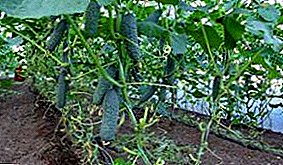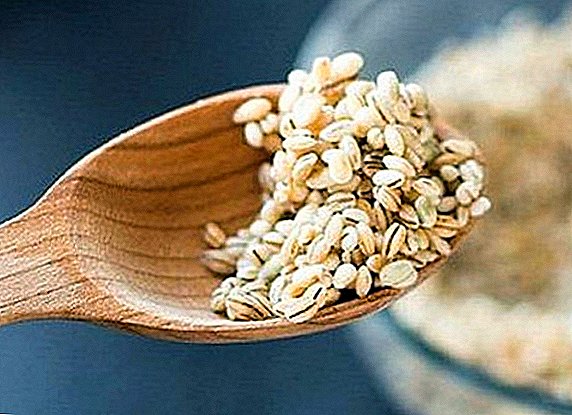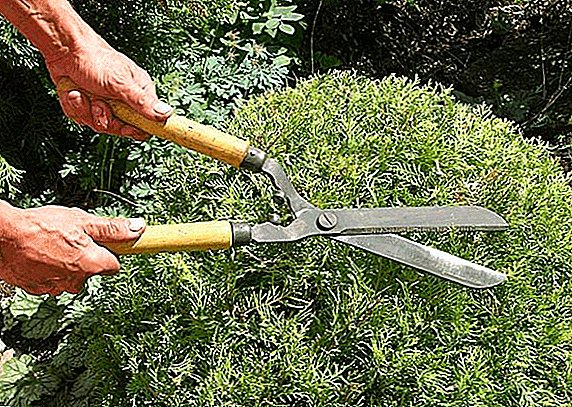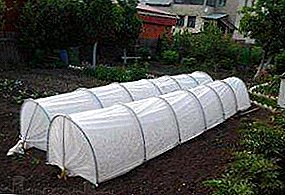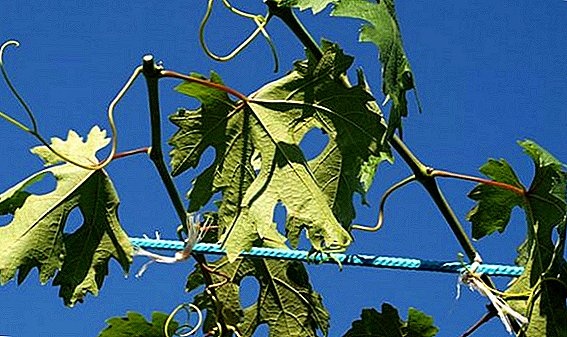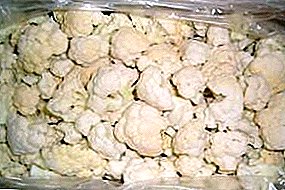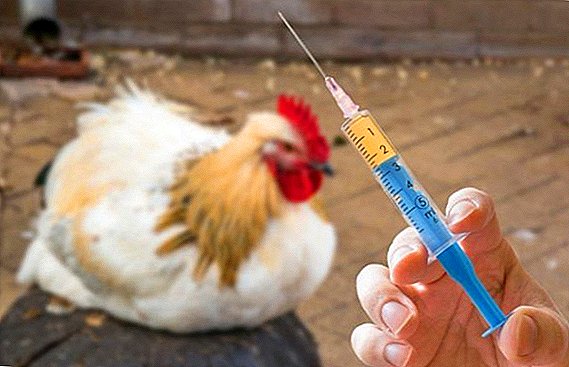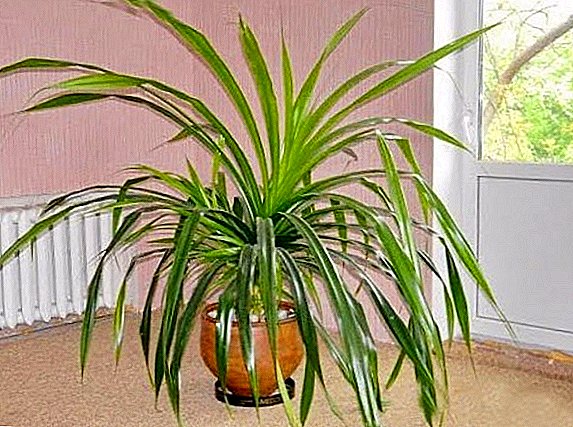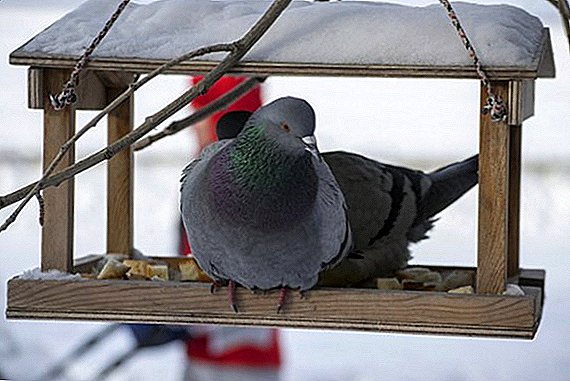 Sooner or later, poultry farmers face the problem of organizing feeders. Of course, you can buy a feeder and in a specialized store, but it is much more interesting to make it on your own and save your budget, because everything that is ready is always more expensive. This article will tell you how to make a pigeon feeder on your own and what is required for this.
Sooner or later, poultry farmers face the problem of organizing feeders. Of course, you can buy a feeder and in a specialized store, but it is much more interesting to make it on your own and save your budget, because everything that is ready is always more expensive. This article will tell you how to make a pigeon feeder on your own and what is required for this.
General requirements for pigeon feeders
If the feeding trough is done correctly, then you will have less problems with care, because a lot depends on this factor: sanitary cleanliness, comfort of birds and ease of cleaning the loft. Of course, you can take the usual capacity, but for the chicks it will be a real challenge, and they will be under stress.
It may also happen that you have to leave for some time, and ask to look after the dovecorn nobody. In this case, this kind of dining room for your pets is the best solution.
You will probably be interested to get acquainted with the peculiarities of keeping pigeons such as duty, Armavir, Kasan, Nikolaev, Uzbek, Volozhsk tape, agarana, Turkish and Baku fighting in the home.
Experienced in breeding pigeons, people advise sharing feeders for adult pigeons and toddlers. After all, the chicks are unusual to be among adults and experienced individuals, and they are likely to be afraid to even get closer to the dining room.  Feeders for our feathered friends are of two types:
Feeders for our feathered friends are of two types:
- automatic;
- box.
Regardless of what type you want to build, it is important to remember the general requirements for any of them:
- birds should have direct access to food;
- the constructed structure must protect the feed well from debris and precipitation;
- the design must be such that it is not difficult to clean;
- the dirt from the pigeon legs should not fall on the prepared food.
Did you know? We are used to the fact that pigeons usually have a not particularly attractive color, but they can be no worse than parrots. For example, there is a variety of fruit pigeons, the plumage of which is of green, red and yellow shades.Having concluded, we can say that any feeders must necessarily have a food tray and a protective cover from debris and other troubles.

What is better to do: choose the material
An important role is played by the choice of material from which the feeder will be made. Experienced golubevody always choose more durable materials, as they are primarily interested in the durability of the structure. But you can use less durable materials, such as cardboard or plastic.
We recommend reading about what diseases you can get from pigeons, how to find out the sex of a pigeon, what life expectancy of pigeons in the wild and at home, how to properly and safely discourage pigeons from the balcony, where you can see pigeons nestlings, and how pigeon mail previously worked .
To make it easier for you to make a choice, we will list the pros and cons of the most popular materials for making pigeon feeders.  Plastic. One of the most popular options for such a device, which has many advantages:
Plastic. One of the most popular options for such a device, which has many advantages:
- easy accessibility;
- because of the transparent walls of the structure, birds will be able to see food from afar;
- easy to handle;
- minimum of garbage and waste;
- no special tools are needed to create such a feeder;
- resistance to temperature and humidity;
- plastic product is strong enough and will last more than one year.
The only drawback that is inherent in plastic is its light weight, so the feeder needs to be well fixed.
Learn how to do pigeon house with your own hands.
Cardboard. The advantages of this material:
- simplicity in work;
- easy accessibility (there is always an unnecessary box in the house).
 But, perhaps, the cons of this material will be typed more:
But, perhaps, the cons of this material will be typed more:- cardboard construction will not withstand heavy rainfall, so it is suitable only for the warm season (but in case of rain it will have to be removed);
- this design will not be durable: it will be enough for only a couple of months;
- the weight of the cardboard feeder will be very light, so that in order not to be blown away by the wind, you will have to make additional fortifications and add something to the feeder itself to make it heavier;
- cardboard - the material is not the most durable, and it can be easily damaged.
Tree. Its benefits include:
- reliability;
- strength;
- durability (if the tree is also treated with a special solution, for example, linseed oil, water-polymer emulsion, etc., the made trough will serve for many years);
- environmental friendliness.
 Wood is probably the best choice in terms of strength and durability, however, for the manufacture of such a feeder, you will need additional tools and at least basic skills in working with wood.
Wood is probably the best choice in terms of strength and durability, however, for the manufacture of such a feeder, you will need additional tools and at least basic skills in working with wood.How to make a pigeon feeder with your own hands
Having figured out what types of feeders are and what material can be used, it remains to build them. Step by step how to make a wooden, plastic and automatic feeder.
Wooden
So, first we list what we need in the manufacturing process.  Necessary materials:
Necessary materials:
- 4 medium boards;
- 1 sheet of plywood;
- 4 wooden bars.
Did you know? Oddly enough, pigeons can boast of excellent vision. For example, they perceive 75 frames per second, and a person is only 24. In addition, they cannot caress bright light and laser beams.Required tools:
- nails, hammer, screwdriver;
- measuring tape;
- ordinary pencil.
 Step-by-step instruction:
Step-by-step instruction:- We collect the main box. For this you need to assemble a box of small size from the prepared boards, it will be the basis of the whole structure. Its sides must be such that the birds are unable to crawl inside. Next on the sides of the boards fix the bars. In more detail you can look at the photo.
- We make a pallet that will move, and a roof for protection. We make a movable pallet of plywood and bars, then we make a roof of the remaining plywood sheet, adjust it in size and attach it to the box.
- We make watering and attach it to the trough, access to clean drinking water never hurts. To do this, on the side of the feeder, fix a homemade water bottle. It is very simple to make it: take a plastic bottle and cut off the bottom. To prevent cuts on the sharp edges of the bottle, you must wrap them with tape - and you will not be cut, and the birds will not hurt themselves. Now turn the bottle neck down and attach it to the side of the box, using a strong cord or metal wire. So that the drinking utensils, which stands below, are gradually filled with water, we make a small hole in the bottle cap. Now, when you pour water into the drinking trough, it will slowly flow down, constantly providing the birds with the necessary amount of moisture.
Important! To prevent the pigeons from landing on the roof, a weather vane should be attached to it, which will scare them away.
Plastic
Now the option is simpler - we make a plastic feeder.
Necessary materials:
- two bottles of plastic, but always of different capacity (if you have a small dovecote, you can take bottles of 2 and 1.5 liters, if not, then you need to take more bottles - 10 and 5 liters).
Required tools:
- knife;
- pencil.
Step-by-step instruction:
- At the smaller bottle and cut off the bottom with a knife with a neck.
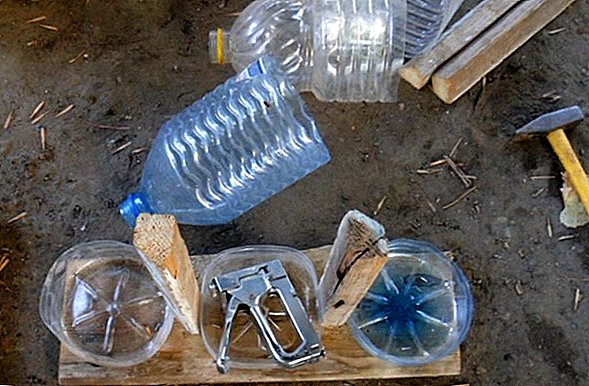
- With a bottle of more we cut only the neck, and leave the bottom.
- Next, with a pencil mark on a small bottle a point closer to the neck and make a small hole. Through it we will fill up the feed.
- Now you need to put a cropped big bottle on a small one. That's it, the feeder is ready.

Automatic
This trough requires a lot of time and effort for its manufacture, however, such a device can be especially useful for you when you are away and you need to somehow provide metered feeding. So let's get started.
Read more about how to make a feeder for birds, quails and chickens (bunker, automatic, as well as PVC pipes).
Necessary materials:
- round plastic container with a lid;
- abrasive wheel or some other load;
- plastic bottle.
Required tools:
- a sharp knife so that you can make holes.
Step-by-step instruction:
- First, take the container and make a hole in it 7-8 centimeters in diameter. The edges must be carefully processed so that the birds do not injure themselves during the meal.

- Birds can turn the feeder, so it is advisable to put some weight on the bottom. For example, use an abrasive wheel, so you not only save the feeder from turning over, but also provide the pigeons with easy grinding of their beak (as in natural conditions), which will save it from excessive growth.
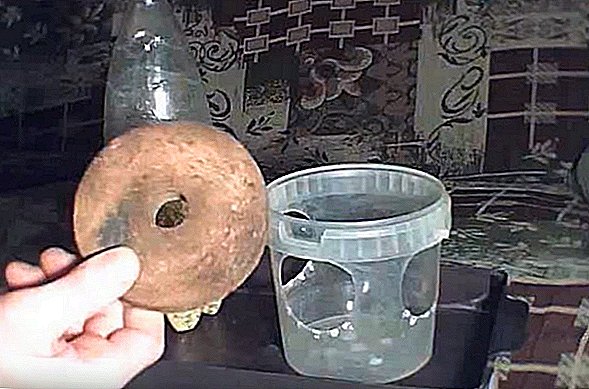
- Next, take the lid from the container and make a hole in it, the diameter of which should coincide with the diameter of the neck of a plastic bottle.

- Make a small hole in the cap of the plastic bottle, put the food in there and close the cap.
- Then turn the bottle directly into the prepared hole in the lid of the plastic container. The bottleneck must not touch the bottom of the container, otherwise the kernels either will not fall out of the bottle at all, or will, but in very small quantities.

Important! The distance from the hole to the bottom of the container should be at least 5-6 cm, so that pigeons can comfortably lose their head in the feeder.Such a feeder will provide not only a metered flow of food, but also cleanliness in the dovecote, because if you just put the food in the bowl, the pigeons will randomly scatter it. Also, to maintain cleanliness, it is recommended to place the feeder in a pan (plastic or metal) so that the scattered grains accumulate in it, and not throughout the entire area around it.
What to feed the pigeons?
If you have not previously bred pigeons, do not put them feeders, you probably wondered that you can pour the pigeons as food. The basis of the diet for pigeons is grain and grass. Grain can be given differently depending on the season and other factors.  We list the main types of grain that can be given to pigeons:
We list the main types of grain that can be given to pigeons:
- barley (special attention is paid to it during moulting);
- barley;
- wheat (its quantity is increased when molting and feeding of chicks);
- millet (gives a lot of energy, it especially needs young animals and sports breeds);
- peeled oats or oatmeal.
Also include legumes in the diet of pigeons, but be careful, because they lead to weight gain. They are usually added to feed at the beginning of a molt, during transport or during breeding and feeding of chicks.
Important! To ration has become full, it is necessary to include table salt.
In the season, do not forget about the grass, you can grow it on your own plot, if there is one, or just pick it on any clean and accessible lawn.  Pigeons also need vitamins and minerals that can be replenished by adding finely chopped herbs (nettle, sorrel, alfalfa or cabbage) and ground shells, eggshell or charcoal to the menu.
Pigeons also need vitamins and minerals that can be replenished by adding finely chopped herbs (nettle, sorrel, alfalfa or cabbage) and ground shells, eggshell or charcoal to the menu.
We advise you to familiarize yourself with the features of breeding and feeding pigeons.
If you want to simplify the task, then instead of the above sources of vitamins and minerals, you can purchase special vitamin and mineral complexes in the pet store. Most of them are water-soluble dragees that are easy to use.
Observing our instructions, it is not difficult to perform any of the feeders on your own and to please your birds with a new device to satisfy their appetite.








